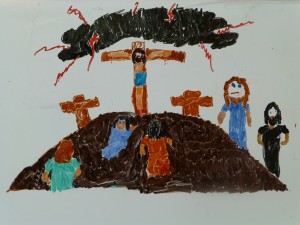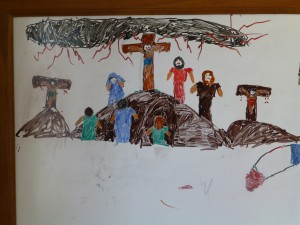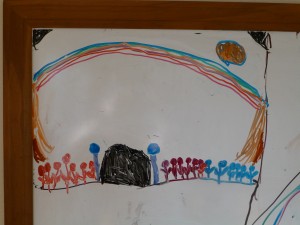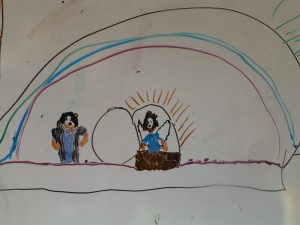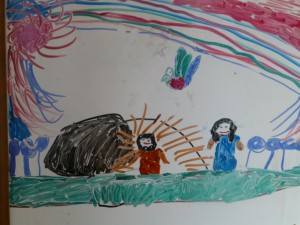According to Pius XII’s encyclical Mediator Dei, the sacrifice of the Mass is offered by the fact that the priest makes the body and blood of Jesus to be present on the altar (see paragraph 92). Despite everything we can say about a “priesthood of all the faithful,” only an ordained priest can turn bread and wine into the body and blood of Jesus. But Pius XII is equally insistent that all of us in the pews really do offer the sacrifice of the Mass. How does that work? Continue reading “3 Ways the Laity Offer the Mass”
Month: April 2015
The Triduum in Pictures
Lift up your heads, you gates….
[This from the apocryphal Gospel of Nicodemus:]
While Satan and Hades were thus speaking to each other, there was a great voice like thunder, saying: Lift up your gates, O you rulers; and be lifted up, you everlasting gates; and the King of glory shall come in. When Hades heard, he said to Satan: Go forth, if you are able, and withstand him. Satan therefore went forth to the outside. Then Hades says to his demons: Secure well and strongly the gates of brass and the bars of iron, and attend to my bolts, and stand in order, and see to everything; for if he come in here, woe will seize us.
The forefathers having heard this, began all to revile him, saying: O all-devouring and insatiable! Open, that the King of glory may come in. David the prophet says: Do you not know, O blind, that I when living in the world prophesied this saying: Lift up your gates, O you rulers? Hosea said: I, foreseeing this by the Holy Spirit, wrote: The dead shall rise up, and those in their tombs shall be raised, and those in the earth shall rejoice. And where, O death, is your sting? Where, O Hades, is your victory?
There came, then, again a voice saying: Lift up the gates. Hades, hearing the voice the second time, answered as if forsooth he did not know, and says: Who is this King of glory? The angels of the Lord say: The Lord strong and mighty, the Lord mighty in battle. And immediately with these words the brazen gates were shattered, and the iron bars broken, and all the dead who had been bound came out of the prisons, and we with them. And the King of glory came in in the form of a man, and all the dark places of Hades were lighted up.
Immediately Hades cried out: We have been conquered: woe to us! But who are you, that have such power and might? And what are you, who come here without sin, who are seen to be small and yet of great power, lowly and exalted, the slave and the master, the soldier and the king, who have power over the dead and the living? You were nailed on the cross, and placed in the tomb; and now you are free, and have destroyed all our power. Are you then the Jesus about whom the chief satrap Satan told us, that through cross and death you are to inherit the whole world?
Then the King of glory seized the chief satrap Satan by the head, and delivered him to His angels, and said: With iron chains bind his hands and his feet, and his neck, and his mouth. Then He delivered him to Hades, and said: Take him, and keep him secure till my second appearing.
[The third Psalm of the Office of Readings today is Psalm 24, long associated with Holy Saturday. Take a look.]
Good Friday: History, Mystery, Practice
Who could explain the mystery of Good Friday? How many books would it take to finish explaining it? It would be impossible. But to talk about the mystery is not today’s duty: the entire goal of Good Friday is to relive the events of that day in all their concreteness. This morning, Jesus was brought to trial before Pilate, and by the afternoon we will witness his final hours on the cross.
The liturgy today has three parts: the liturgy of the word, the veneration of the cross, and Holy Communion. Each part has something unique about it to make this day different from all others. Continue reading “Good Friday: History, Mystery, Practice”
Free for use: One spacious upper room, furnished.
Yesterday was the day English tradition has called “Spy Wednesday,” because on that day Judas made a deal with the authorities to betray Jesus and began looking out for an opportunity to do so (Mark 14:10-11). Immediately after this scene, Mark tells us what happened on Thursday (14:12-16):
And on the first day of Unleavened Bread, when they sacrificed the Passover lamb, his disciples said to him, “Where will you have us go and prepare for you to eat the Passover?” And he sent two of his disciples, and said to them, “Go into the city, and a man carrying a jar of water will meet you; follow him, and wherever he enters, say to the householder, ‘The Teacher says, Where is my guest room, where I am to eat the Passover with my disciples?’ And he will show you a large upper room furnished and ready; there prepare for us.” And the disciples set out and went to the city, and found it as he had told them; and they prepared the Passover.
The sequence is clear: Judas the spy is on the prowl, so Jesus does not give out any information ahead of time about where the Last Supper will take place. He doesn’t even whisper to another disciple, who might be persuaded to spill the beans. Instead, he sends two disciples to follow someone they will meet randomly in the city. And the miracle is, with Jerusalem swollen to triple its normal population and Passover celebrations fighting for room literally on the rooftops, this random person leads them to a spacious room all furnished and still available! It’s like getting Superbowl tickets the day before the game!
But my thoughts today keep going back to the owner of the room. Today, on Holy Thursday, Jesus’ ministers will say to me, “Where is the guest room, where I am to eat the Passover with my disciples?” That householder was ready without warning; I have had all of Lent to prepare. I still wonder if my inner, upper room is furnished and ready for tonight.
Behold, I stand at the door and knock; if any one hears my voice and opens the door, I will come in to him and eat with him, and he with me. (Revelation 3:20)
Holy Thursday: History
Among the Holy Week liturgies, I have a special soft spot for the Holy Thursday evening Mass. A tender atmosphere of love surrounds the ceremony itself, giving way to a sense of desolation when the altar is stripped at the end. As it turns out, these two moods, tender love and brooding sorrow, match the two main streams of Holy Thursday’s history.
The first stream gives us a sense of sorrow. Not surprisingly, it was the astonishing Cyril of Jerusalem in the 4th Century who introduced special customs for the Thursday before Easter:
- In the morning the Jerusalem church celebrated Mass in the chapel of the Cross, something they never did any other day of the year. It was customary for all to receive communion.
- A second Mass was celebrated at about 4:00 in the afternoon to begin an evening of reliving what happened that night in Jerusalem long ago.
- Afterwards, the whole congregation kept vigil at a church on the Mount of Olives, with readings on the last supper.
- They visited Gethsemane after midnight for a reading on the agony in the garden.
- Finally, they returned to the city in the morning for a reading of the gospel of the trial of Jesus. When this passage was read, the pilgrim Egeria recounts, there was a loud “moaning and groaning with weeping from all the people.”
Many things have changed, but Cyril set the pattern. To this day we have an evening Mass with a special emphasis on the mystery of the Eucharist; the faithful are not supposed to receive Communion at any other Mass that day, to emphasize their Communion together in the evening. After the Mass, the host is carried in a special procession to a separate tabernacle, representing Jesus going out into the night with his disciples. People stay afterwards for a period of adoration, remembering that Jesus asked his disciples to stay and keep watch with him. The altar is stripped bare, emphasizing the sense that Jesus has left the sanctuary, has gone out into the night to meet his betrayer.
A second stream contributes to the atmosphere of tender love. Some time after Cyril’s practices had begun to spread throughout the Christian world, the washing of feet became part of the Holy Thursday tradition. There is no documentary evidence of this until the 7th century, but the texts from that time seem to imply a somewhat earlier origin. Some surprising facts:
- Until Pius XII’s reforms in 1955 it was not celebrated as part of the Mass, and in some places it is still separate from the Mass.
- There was often a separate hall or building where it was done, and the focus of the ceremony was on an act of love, especially for the poor. In one 11th century monastic version of the ritual, the abbot and his monks genuflected and bowed down to adore Christ in the poor men whose feet they were about to wash.
- In the Middle Ages in many places it was customary for the king to wash the feet of poor men and then wait on them at table, although if a queen was on the throne then she would wash the feet of poor women. Modesty forbade men from washing women’s feet, or women men’s.
- The first word of the first antiphon sung during the foot-washing ritual was mandatum, from which we seem to get our English name for the day, “Maundy Thursday” as well as our name for the foot-washing ceremony itself, the “Mandatum”.
In the current rubrics, the entire rite is optional, celebrated “where a pastoral reason suggests it.” The tradition that men only wash the feet of men has carried over into the rubrics, which require that the priest wash the feet of viri, of men. Although it has become customary to wash the feet of twelve men, no particular number is mandated by tradition and the rubrics do not specify a number.


